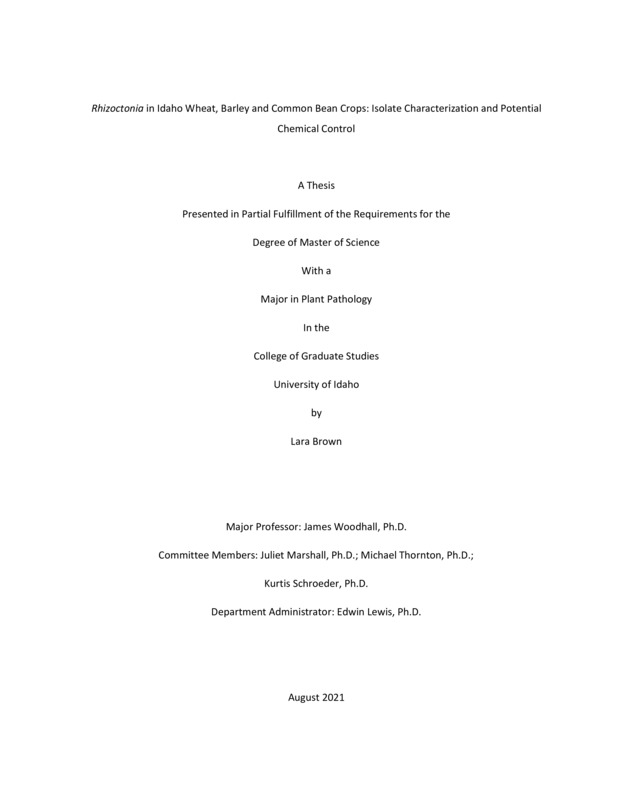Rhizoctonia in Idaho Wheat, Barley and Common Bean Crops: Isolate Characterization and Potential Chemical Control
Brown, Lara. (2021-08). Rhizoctonia in Idaho Wheat, Barley and Common Bean Crops: Isolate Characterization and Potential Chemical Control. Theses and Dissertations Collection, University of Idaho Library Digital Collections. https://www.lib.uidaho.edu/digital/etd/items/brown_idaho_0089n_12131.html
- Title:
- Rhizoctonia in Idaho Wheat, Barley and Common Bean Crops: Isolate Characterization and Potential Chemical Control
- Author:
- Brown, Lara
- Date:
- 2021-08
- Embargo Remove Date:
- 2022-09-01
- Program:
- Plant, Soil and Entomological Sciences
- Subject Category:
- Plant pathology
- Abstract:
-
Rhizoctonia and associated fungi are an important group of soil-borne pathogens. Three groups of Rhizoctonia fungi are important for plant diseases, these are the multinucleate Rhizoctonia solani and Waitea circinata, as well as binucleate Rhizoctonia species (BNR). The Rhizoctonia species complex is characterized through the affinity for hyphal fusion and isolates can be assigned to anastomosis groups (AGs) based on the specific hyphal fusion affinity. The Rhizoctonia solani complex is comprised currently of thirteen known AGs, with twenty-nine subgroups. The BNR complex consist of twenty AGs with eight subgroups, including the most recently found AG W, found in China on potatoes (Solanum tuberosum) in 2015. There are five varieties that are known within Waitea circinata in the newly placed Corticacaeae family. AGs can differ in, means of dispersal, host range, fungicide sensitivity (Kataria and Gisi 1999) and aggressiveness, even to certain plant parts, such as R. solani AG 8 almost exclusively infecting the roots of potatoes (Woodhall et al. 2008). Multiple AGs have been implicated causing disease in wheat, barley and common beans.
Optimum disease management based on the knowledge of the AG, or even AG subgroup present, is essential for correct diagnosis. Presently there is limited knowledge of the AGs present on wheat, barley and common bean crops in Idaho. Furthermore, there is very limited knowledge of the AGs present in Idaho and the specific diseases they cause, particularly for Southern Idaho where there is a diverse range of crops grown. Therefore, this study aimed to determine which species, AGs or subgroups are associated with Rhizoctonia diseases were present in wheat, barley and common bean crops in Idaho. 118 commercial wheat and barley fields and 102 commercial common bean fields were sampled in 2018, 2019 and 2020 resulting in 238 wheat and barley isolates and 188 common bean isolates of Rhizoctonia and related groups. Isolate identity was determined using rDNA ITS sequencing and phylogenetic analysis with known reference strains. Of the isolates collected, Waitea circinata varieties were most prevalent in wheat and barley, while AG 4 HG-II was the most prevalent in common beans. Phylogenetic placement showed three unidentified BNR isolates and five unidentified Waitea circinata varieties for wheat and barley. Phylogenetic placement for beans showed two unidentified AG 11 clades. For cereal fields, the relative incidence of Rhizoctonia solani AGs 2-1, 4 HG-II, 5, 8 and BNR AG D (I) was also determined using real-time PCR on directly extracted soil DNA samples. This determined that AG2-1 was widely present in cereal fields prior to planting. With 62 wheat and barley isolates and 61 common bean isolates, replicated glasshouse experiments were undertaken to determine their relative aggressiveness to each host. For cereals BNR AG D was the most aggressive, whilst AG 4 HG-I was most aggressive for beans. Finally, the effectiveness of various fungicides to control Rhizoctonia was evaluated in a laboratory based EC50 assay to 23 isolates, whilst for AG 11, which was determined to significantly reduce bean yields in preliminary experiments, a field and glasshouse experiment was undertaken to determine the effectiveness of serval fungicides to control the pathogen in pinto beans. These experiments indicate that inpyrfluxam and prothioconazole showed most potential to manage the pathogen.
- Description:
- masters, M.S., Plant, Soil and Entomological Sciences -- University of Idaho - College of Graduate Studies, 2021-08
- Major Professor:
- Woodhall, James
- Committee:
- Marshall, Juliet; Thornton, Michael; Schroeder, Kurtis
- Defense Date:
- 2021-08
- Identifier:
- Brown_idaho_0089N_12131
- Type:
- Text
- Format Original:
- Format:
- application/pdf
- Rights:
- In Copyright - Educational Use Permitted. For more information, please contact University of Idaho Library Special Collections and Archives Department at libspec@uidaho.edu.
- Standardized Rights:
- http://rightsstatements.org/vocab/InC-EDU/1.0/

